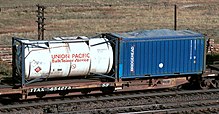
A liquid hydrogen tank-tainer, also known as a liquid hydrogen tank container, is a specialized type of container designed to carry cryogenic liquid hydrogen (LH2) on standard intermodal equipment. [1] The tank is held within a box-shaped frame the same size and shape as a container.